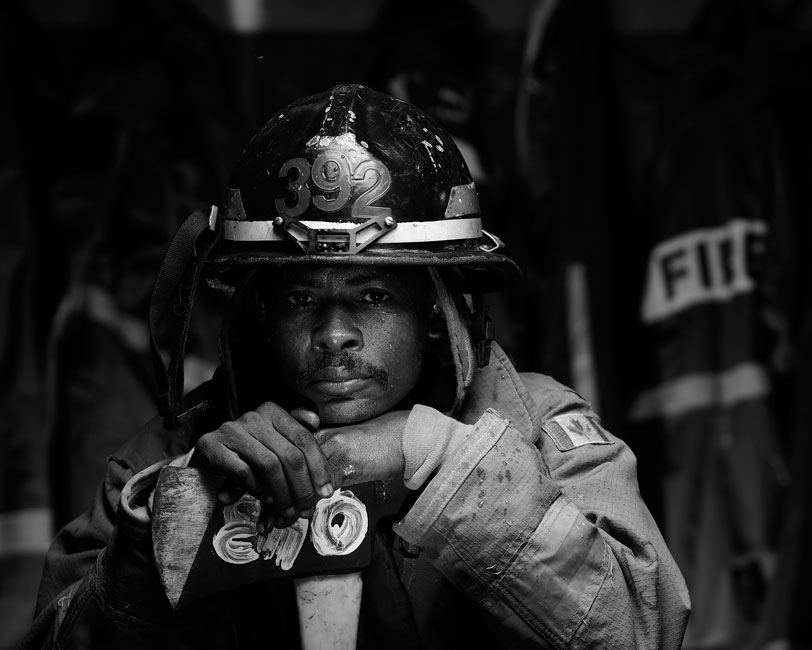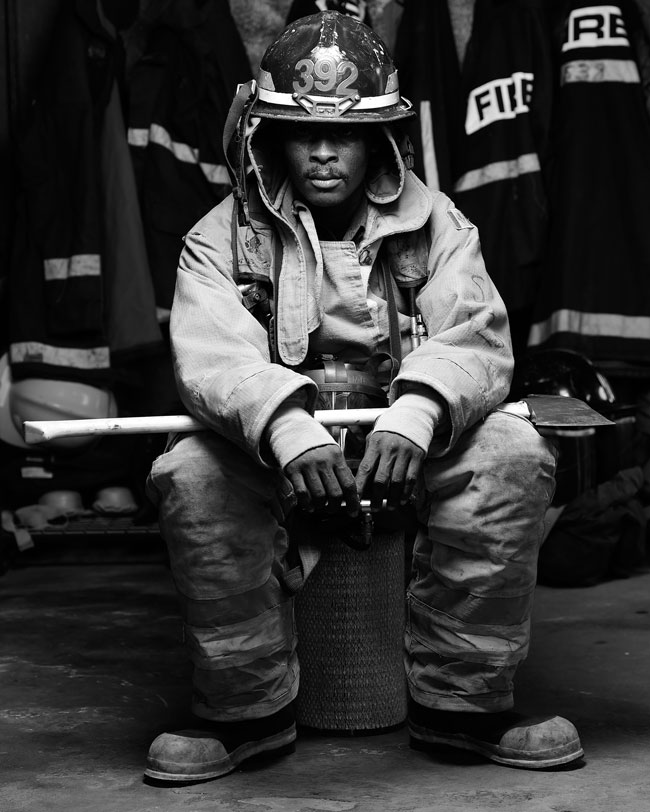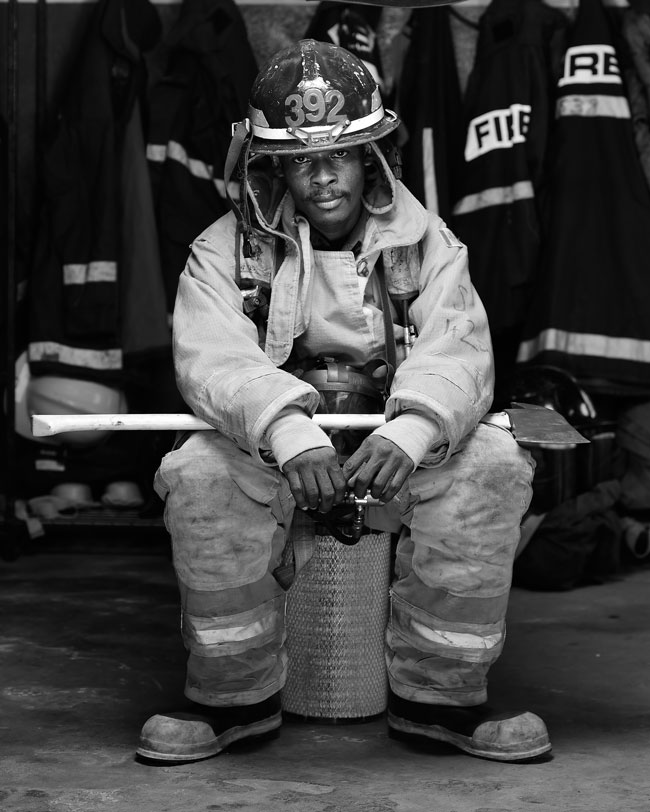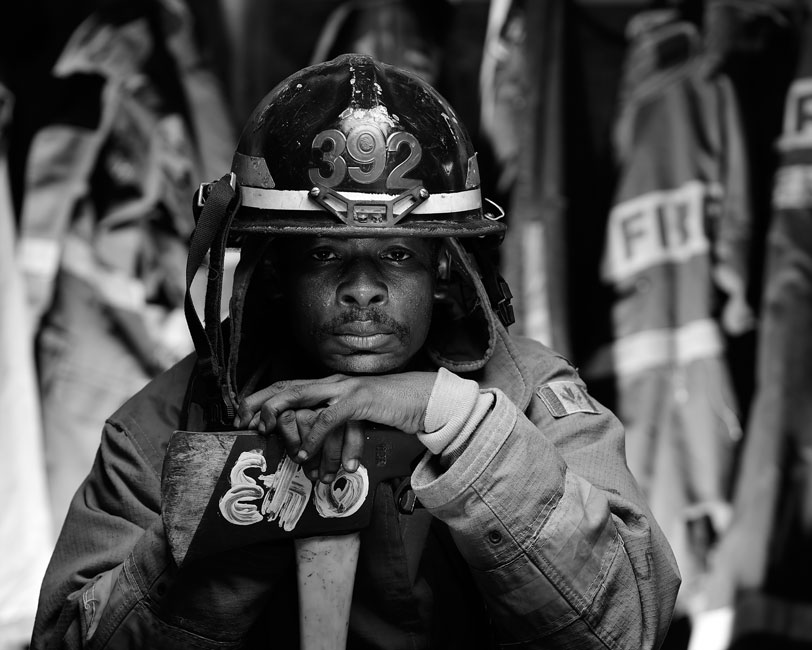Joe McNally: Shooting a Portrait with Speedlights
Firefighters. They share, along with cowboys, an innate ability to simply step in front of a camera and become a photograph. Henry, of the Soufriere Fire Department in St. Lucia, has a look, a presence, if you will, that speaks to the camera.
To do this portrait, I made some camera moves before I even put it to my eye. When doing what one might call a "formal" portrait, I've always enjoyed a more blocky type of aspect ratio. Don't know exactly why. It might hark back to film days when I shot a lot of 6x7 and square medium format stuff. In the D4S there is a menu setting where you can alter your frame from the standard DSLR view to 5x4, which is what I did here. I also shifted into Monochrome. I still have color in the raw file, but when I shoot B&W, I like to see in B&W. It makes a difference. I rarely shoot in color and then convert it to monochrome later. I try my best to think and see in the palette I am shooting, at the moment of exposure.
One subject? One light, at least to start. (Best to keep it simple and move fast when working with firefighters, as they’re likely to disappear at any moment.)
Here’s where light placement, hence a C-stand, comes in, well, not just handy, but pretty much essential. Depending on your taste, of course. You can light from the side, or elsewhere. You can light from any place you want. But, my instincts said, light from overhead, symmetrically, and for this, you’ve got to extend, or boom the light source.
Which is, in this particular equation, a 24” white interior Lastolite hotshoe soft box. Handy, simple, all purpose light source. It’s pretty soft and forgiving, but also directional, hence the shadows.
With only one light, its a pretty good start, but you don't see the subject's eyes.
It gives Henry a look, for sure. It’s moody, and has attitude. But, pitched from up above, that’s all it gives. You don’t see the eyes.
Want the eyes? That calls for another light, given the attitude of the first light, which I didn’t want to change. I washed a Group B TTL light off the silver reflective sleeve of a Lastolite trip-grip diffuser, placed on the floor, about 8’ in front of the subject. Voila! Eyes.
A second light is added to illuminate the subject's eyes: from a Speedlight bounced into a reflector 8' in front of the subject, but the moodiness is diminished now.
But, this is a wash of light, it flows upwards towards Henry, and lights not just his eyes, but it puts details into his overall frame and what he’s sitting on, which happens to be some sort of air filter we found in the firehouse. It's nice enough, but not really specific. If you want a light just dedicated to his eyes, best to use something like a gridded or snooted source, something that produces a small, concentrated splash of light that really locates the eyes and not much else.
For the above, there are a couple things you could use. Lastolite makes a gridded, magnetized snoot that is collapsible and cool. It travels well, and the whole kit, with the grids, frame and snoot give you lots of options. The big blow of light behind Henry is the same contraption I had just used to fill the front of him. It's a Speedlight bounced into a silver tri-grip.
Give a little, get a little, is the rule of location. Other rules abound. Solve one problem, create two more. Murphy's law. The frequency of the bread falling butter side down is in direct relationship to how expensive the carpeting is. etc.
In this shot, the overhead softbox is still illuminating the subject; the general fill has been moved to light up the background; and a more direcct, snooted fill has been added to light up his eyes.
Location is problem solving, often times. Eliminating the frontal, general fill and going with a very specific source meant I lost a touch of detail in the background. So, I pulled the floor fill rig around to the back of Henry, to light up the rack of bunker gear hanging back there. True to the general pattern of TTL, the camera's brain rightly perceived that area to be dark and pumped out too much light, as you can see above.
Plugged in - 2 EV (also tried - 3) and dialed up the background to a decent, moody level.
We ended up here, with three lights. Group A, overhead, boomed Lastolite 24" hot shoe soft box. Group B, fill snoot for his face and eyes, running low power, about - 3 EV. And the background, Group C, a bounce off of a silver reflective surface (the Speedlight is just laying on it) running in similar toned down fashion, minus 2 or 3.
Final image: D4S, 1/20th, f/5.6, 70-200mm f/2.8, set at 170mm. Three lights: Group A, overhead Speedlight, boomed Lastolite 24" hot shoe soft box. Group B Speedlight, fill snoot for his face and eyes, running low power, about - 3 EV. And the background Speedlight, Group C, a bounce off of a silver reflective surface (the Speedlight is just laying on it) running in similar toned down fashion, minus 2 or 3.
Here's the final camera specs. D4S, 1/20th, f/5.6, 70-200mm f/2.8, set at 170mm. I have minus three programmed into the camera, but the D4S ignores that command because of it being set in manual mode. I did my scout in aperture priority, getting the rough exposure for the scene dialed in, and then flipped the camera into manual to proceed through the making of the shot.









